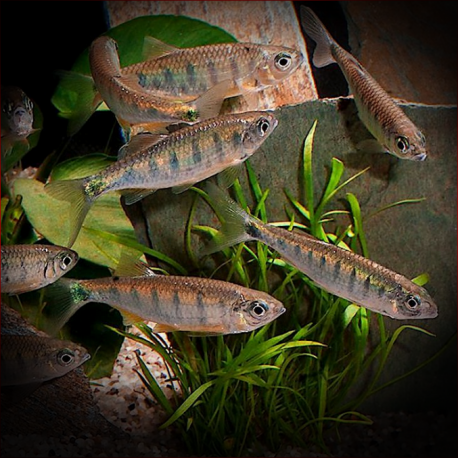More info
Datasheet
| Minimum Tank Size | 540 litres / 142.65 US gallons |
| Maximum Size | 8.5cm / 3.35inches |
| Temperature | 18°C / 64.40°F - 24°C / 75.20°F |
| Hardness | 2.02dgH / 36ppm - 12.05dgH / 215ppm |
| pH | 6.0-7.5 |
General Description
The Opsarius Dogarsinghi, commonly known as Manipur Baril, belongs to the family Cyprinidae and can reach a maximum size of 8.5cm. It is occasionally found in the ornamental trade under names such as 'Burmese hill trout' and 'striped hill trout'. This species is characterized by specific features such as predorsal scales numbering 20, a dark blotch at the base of the caudal fin, and dark blue vertical bars on its body.
Aquarium Setup
For optimal care, a tank setup resembling a flowing stream or river is ideal for the Opsarius Dogarsinghi. The tank should have a substrate of rocks, sand, fine gravel, and larger boulders, possibly with driftwood roots and branches. While most aquatic plants struggle in such conditions, hardy varieties like Microsorum, Bolbitis, or Anubias can be attached to the decor. It is crucial to maintain spotless water with high oxygen levels and moderate water movement. Regular water changes of 30-50% of the tank volume per week are necessary, and the tank should have a secure cover as Opsarius species are known to jump.
Behaviour
The Opsarius Dogarsinghi is not suitable for community tanks due to its specific environmental needs. Being fast swimmers and vigorous feeders, they may outcompete or intimidate slower or smaller fish species during feeding times. This species forms shoals with a distinct pecking order. It is recommended to keep them in groups of five or more individuals to prevent bullying among subdominant fish.
Feeding and Diet
In their natural habitat, Opsarius spp. primarily feed on aquatic and terrestrial insects, small fish, and benthic invertebrates. In an aquarium, they can be fed high-quality dried foods supplemented with live or frozen options like bloodworms, Artemia, chopped earthworms, Drosophila fruit flies, and gut-loaded crickets.
Reproduction & Dimorphism
Information on the reproduction of Opsarius Dogarsinghi in an aquarium setting is limited. However, adult females tend to be less brightly colored and larger than males, especially when gravid. Nuptial males develop tubercules on their heads and orange pigmentation in the lower body region.
Habitat and Distribution
This species inhabits well-oxygenated, moderate to fast-flowing rivers and streams with substrates of gravel, cobbles, boulders, and exposed bedrock. Opsarius Dogarsinghi is primarily found in the Chindwin River system in Manipur and Nagaland states, northeastern India, with some occurrences in Myanmar. Its distribution may be restricted to the Manipur and Yu affluent drainages and nearby river basins.

